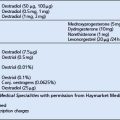CHAPTER 1 CONTRACEPTION
INTRODUCTION
FRASER GUIDELINES
A doctor must consider the following issues when the patient is under 16 years old:
COMBINED ORAL CONTRACEPTIVE (COC)
STARTING THE COC
Management
The following points should be considered and discussed, if appropriate:
How to start the COC
Risks of taking the COC
Prescribing.
Common choices for women free of risk factors for arterial disease under the age of 30 years are pills delivering levonorgestrel or norethisterone. Women with risk factors for arterial disease or those who are relatively intolerant of pills containing levonorgestrel or norethisterone may do better on a pill containing a third-generation progestogen.
What to do if a pill is missed
Management of subsequent problems
Breakthrough bleeding
If BTB persists for >2–3 months after starting the COC, try an equivalent pill with a different progestogen (see pill ladder, p. 5) or a pill with a higher oestrogen or progestogen content or change to a triphasic pill.
PROGESTOGEN-ONLY PILL (POP)
The POP is particularly useful for the following:
STARTING THE POP
Management
The following points should be considered and discussed.
Irregular bleeding or amenorrhoea.
These may occur. Most women have a cycle of between 25 and 35 days. The blood loss is light.
How to start the POP
What to do if a pill is missed
Take it as soon as it is remembered and carry on with the next pill at the right time. If a pill is taken more than 3 hours late (12 hours for Cerazette), protection may be lost. Continue normal pill-taking and take extra contraceptive precautions for 48 hours. Emergency (oral or IUCD) postcoital contraception (see p. 11) should be offered after any unprotected intercourse which occurs during the 7 days after missing 1 pill by more than 3 hours.
INJECTABLE PROGESTOGENS
The main side-effects are (as for the POP):
Depo-Provera reduces bone mineral density in many women who use it. This reduction occurs in the first 2–3 years of use and then stabilises. In adolescents, Depo-Provera should only be used when other methods of contraception are inappropriate. Consider other methods of contraception in women with risk factors for osteoporosis (see p. 243). Formally re-evaluate women who have used Depo-Provera for more than 2 years.
PROGESTOGEN-RELEASING IMPLANT (IMPLANON)
POSTCOITAL (EMERGENCY) CONTRACEPTION
HORMONAL EMERGENCY CONTRACEPTION
EMERGENCY IUCD
Assessment
History.
DIAPHRAGM
The failure rate of the diaphragm is about 4/100 woman-years.
INTRAUTERINE CONTRACEPTIVE DEVICE (IUCD)
Management
Insertion.
Insertion should be in the first 14 days of the cycle and the contraceptive effect is immediate.
Women at high risk of Chlamydia infection should be screened (see p. 46). Take swabs for Chlamydia and await results before inserting IUCD, if possible. Those at high risk:
Advice
Main disadvantages of IUCDs
NATURAL BIRTH CONTROL
CALENDAR METHOD
Method of calculation
This method has a high failure rate, even with good compliance.




